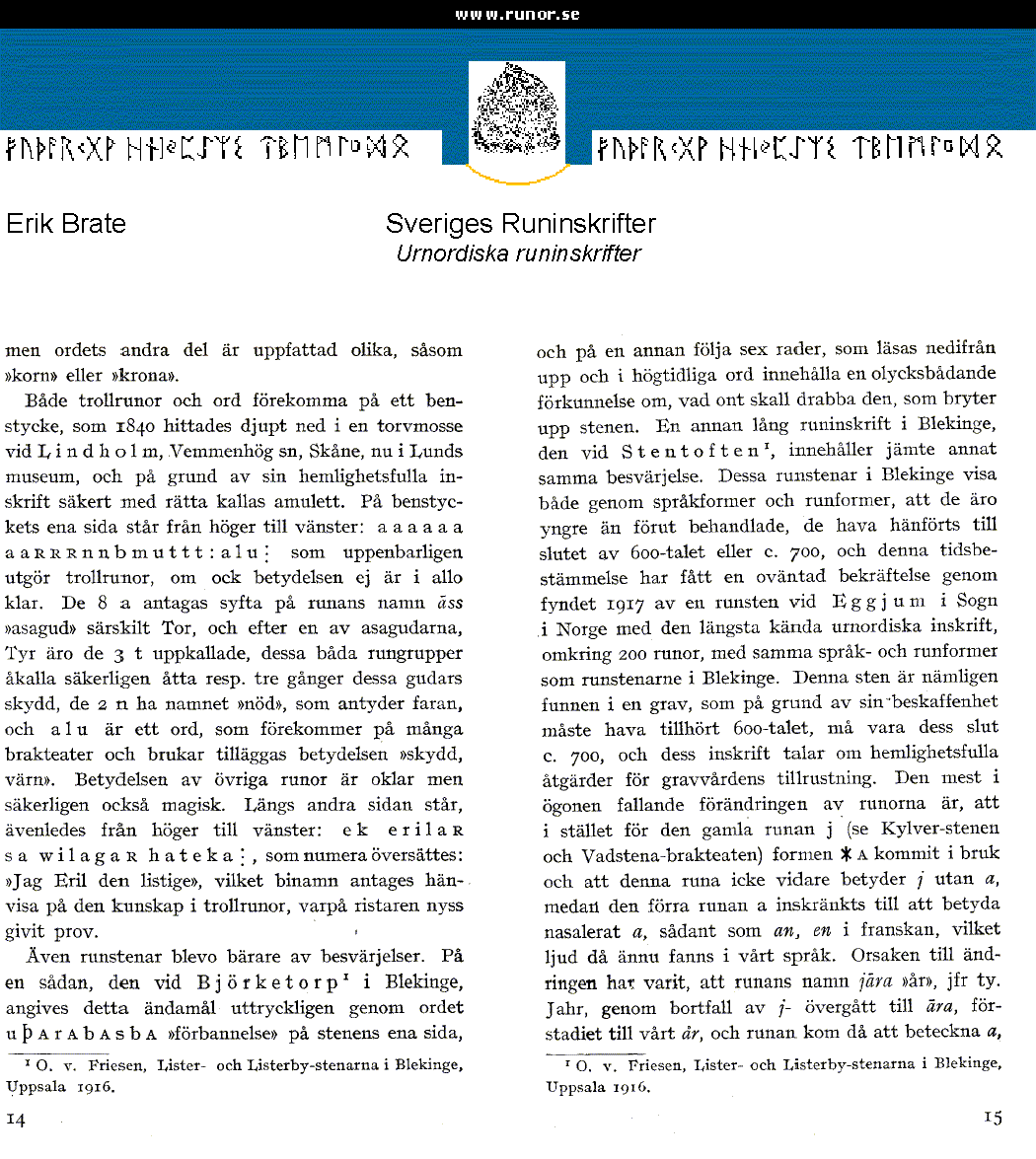
Both magic runes and words occur on a bone fragment, which in the year
1840 was found deep down in a peat bog at Lindholm,
Vemmenhög, Skåne,
now in Lund's museum, and because of its secretive inscription, called
amulet. On one side of the bone fragment stands from right to left: aaaaaaaaRRRnnbmuttt:
alu:
which clearly constitutes magic runes, even if the importance is not
clear at all. The 8 a is assumed to aim on the runes names asgod “the sir” special Thor, and after one of
the sir, is the 3 t named, these both sequences of runes invoke eight
respective three times these gods' protections, the 2 n have the name
”need”, that implies the danger, and alu is a word,
that occurs on many bracteates and use to be added the meaning
“protection”. The importance of other runes is unclear but doubtless
also magic. Along the other side stands, also from right to left:
ek erilaR sa
wilagaR hateka;
which now a days is translated: “I Earl the cunning”, which side
name is assumed refer to that knowledge in magic runes, where upon the
carver just show proof.
Also runic stones are bearers of
invocations. One such as Björketorp (1) in Blekinge, is stated this purpose expressly through the word
uþArAbAsbA
“curse” on one of the stone's side,
(1) O, v. Friesen, Lister - och Listerby-stenarna i Blekinge, Uppsala 1916.
and on another follow six rows, that to be read from below up
and in dignified words to contain an ominous foreshadow to see about,
what evil will hit they, that breaks up the stone. Another long runic
inscription in Blekinge, at Stentoften (1), contains the same
invocation.
These runic stones in Blekinge both through language shapes and runic character, are younger than the previous inscriptions and have been related to the end of the 7th century or c. 700 AD, and this time provision has got an unexpected acknowledgment through the finding 1917 of a runic stone at Eggjum in Sogn in Norway with the longest well-known Primitive Nordic inscription, about 200 runic, with same language - and runic shapes as the runic stones in Blekinge. This stone is found in a grave, that because of its characteristic must be originate in the 7th century, and ends of c. 800, and its inscription speaks about secret full proceedings for the sepulchral monument's protection.
The most striking in the change of the runics is, that instead of the old rune j (see Kylver-stone and Vadstena-bracteate) the character * A come in use and that this rune non further means j and is replaced by a, while the previous rune a been limited to meaning nasal a, such as an, “en” in the French, which sound then still existed in our language.
The reason to the change has been, that the rune names jära “years”, comp. Germen, Jahr, through losses of j - passed on to ära, the stem stage to our year, and the rune then denoted a,
(1) O. v. Friesen, Lister - och Listerby-stenarna in Blekinge, Uppsala 1916.
These runic stones in Blekinge both through language shapes and runic character, are younger than the previous inscriptions and have been related to the end of the 7th century or c. 700 AD, and this time provision has got an unexpected acknowledgment through the finding 1917 of a runic stone at Eggjum in Sogn in Norway with the longest well-known Primitive Nordic inscription, about 200 runic, with same language - and runic shapes as the runic stones in Blekinge. This stone is found in a grave, that because of its characteristic must be originate in the 7th century, and ends of c. 800, and its inscription speaks about secret full proceedings for the sepulchral monument's protection.
The most striking in the change of the runics is, that instead of the old rune j (see Kylver-stone and Vadstena-bracteate) the character * A come in use and that this rune non further means j and is replaced by a, while the previous rune a been limited to meaning nasal a, such as an, “en” in the French, which sound then still existed in our language.
The reason to the change has been, that the rune names jära “years”, comp. Germen, Jahr, through losses of j - passed on to ära, the stem stage to our year, and the rune then denoted a,
(1) O. v. Friesen, Lister - och Listerby-stenarna in Blekinge, Uppsala 1916.